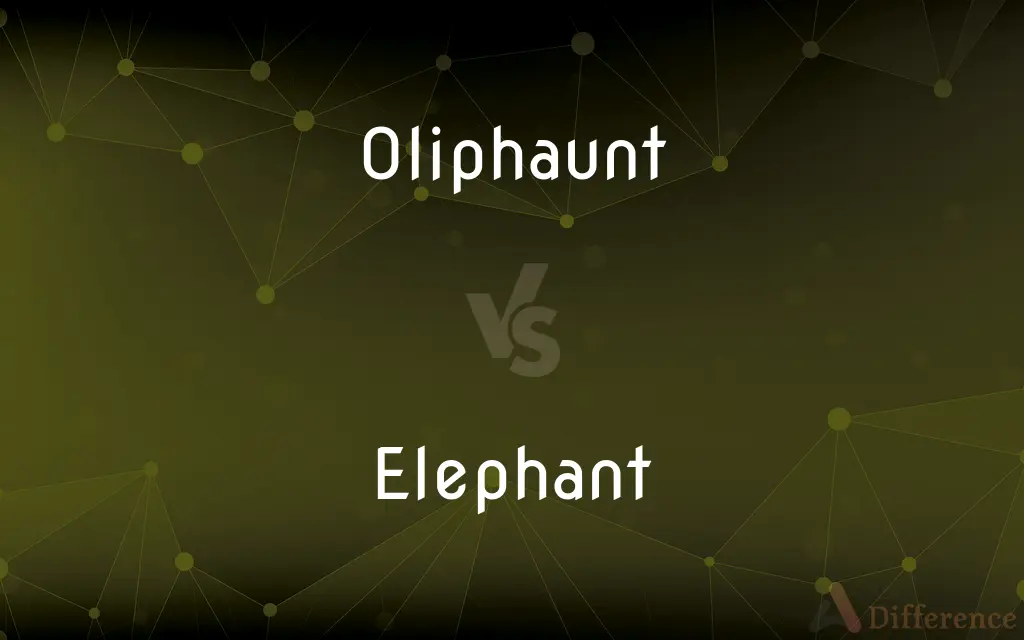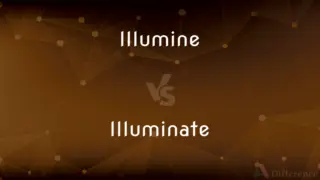Oliphaunt vs. Elephant — What's the Difference?
Edited by Tayyaba Rehman — By Fiza Rafique — Updated on April 25, 2024
An Oliphaunt, featured in Tolkien's mythology, is a fantastical creature resembling an enormous elephant with increased strength and size, while an elephant is a real, large mammal known for its intelligence and social behavior.

Difference Between Oliphaunt and Elephant
Table of Contents
ADVERTISEMENT
Key Differences
The term Oliphaunt is used in J.R.R. Tolkien's legendarium to describe immense, mythical creatures akin to elephants but of a much larger scale and possessing great strength. On the other hand, elephants are real-world animals, the largest land mammals, known for their distinct large ears and long trunks.
Oliphaunts, as depicted in "The Lord of the Rings," are used primarily in warfare, bearing towers and armed men on their backs, which highlights their fantastical and war-like utilization in Middle-earth. Whereas, elephants are often found in the wild in Africa and Asia and are also used in various human activities like logging, ceremonies, and sometimes in historical warfare, but not to the mythical extent of Oliphaunts.
In terms of physical appearance, Oliphaunts are described as towering and terrifying with multiple tusks and enormous bodies that eclipse even the largest of real elephants. Elephants, while large, are known for their more practical anatomy adapted to their environments, such as having large ears that help regulate their body temperature.
Cultural significance also differs; Oliphaunts are part of a fictional universe, contributing to the rich tapestry of Middle-earth mythology and symbolizing the might of certain armies. In contrast, elephants have a deep cultural and symbolic significance in many real-world cultures, symbolizing wisdom, memory, and power.
Conservation status is another area of contrast. Oliphaunts, being fictional, do not require conservation efforts. Real elephants, however, are often at the center of conservation programs due to threats from habitat loss and poaching.
ADVERTISEMENT
Comparison Chart
Origin
Fictional (Tolkien's Middle-earth)
Real-world (Africa, Asia)
Size
Larger than any real elephant
Up to 4 meters at the shoulder
Usage
War creatures in fantasy
Work, ceremonies, and wild
Physical Characteristics
Multiple tusks, enormous size
Large ears, long trunk
Conservation
Not applicable
Subject to conservation efforts
Compare with Definitions
Oliphaunt
Used in warfare in Middle-earth, bearing armaments and soldiers.
The warriors mounted the Oliphaunt as they prepared for the siege.
Elephant
Can be found in the wild in Africa and Asia.
The African elephant roamed freely across the savannah.
Oliphaunt
A mythical beast from Tolkien’s universe, much larger than real elephants.
The Oliphaunt in the battle scene overshadowed all other creatures.
Elephant
Involved in human activities such as logging and ceremonial uses.
In the festival, the decorated elephant carried the king.
Oliphaunt
Known for their enormous size and strength in Tolkien's lore.
The Oliphaunt could trample any opposition with ease.
Elephant
A large mammal with a long trunk and big ears, known for its intelligence.
The elephant used its trunk to fetch water.
Oliphaunt
Features in tales and songs within the story, symbolizing might.
Legolas aimed his arrow at the mighty Oliphaunt.
Elephant
Lives in herds and exhibits complex social behaviors.
The elephant herd communicated through subsonic rumbles.
Oliphaunt
A creature of legend, not found in the real world.
Children marveled at the tales of the gigantic Oliphaunt.
Elephant
Subject to various conservation efforts worldwide.
Conservationists launched a new initiative to protect elephants from poaching.
Oliphaunt
Elephant
Elephant
Elephants are a select group of proboscideans belonging to the family Elephantidae. They are the largest existing land animals.
Elephant
Any of several very large herbivorous mammals of the family Elephantidae native to Africa, South Asia, and Southeast Asia, having thick, almost hairless skin, a long, flexible, prehensile trunk, upper incisors forming long curved tusks of ivory, and, in the African species, large fan-shaped ears.
Elephant
Any of various extinct animals of the family Elephantidae.
Elephant
A mammal of the order Proboscidea, having a trunk, and two large ivory tusks jutting from the upper jaw.
Elephant
(in particular) Any member of the subfamily Elephantinae not also of the genera Mammuthus and Primelephas.
Elephant
(figuratively) Anything huge and ponderous.
Elephant
Synonym of elephant paper
Elephant
Used when counting to add length, so that each count takes about one second
Let's play hide and seek. I'll count. One elephant, two elephant, three elephant...
Elephant
Ivory.
Elephant
(xiangqi) A xiangqi piece, that is moved two points diagonally, may not jump over intervening pieces and may not cross the river.
Elephant
A mammal of the order Proboscidia and family Elephantidae, of which two living species, Elephas maximus (formerly Elephas Indicus) and Loxodonta Africana (formerly E. Africanus), and several fossil species, are known. They have five toes, a long proboscis or trunk, and two large ivory tusks proceeding from the extremity of the upper jaw, and curving upwards. The molar teeth are large and have transverse folds. Elephants are the largest land animals now existing. The elephant is classed as a pachyderm.
Elephant
Ivory; the tusk of the elephant.
Elephant
Five-toed pachyderm
Elephant
The symbol of the Republican Party; introduced in cartoons by Thomas Nast in 1874
Common Curiosities
What is an Oliphaunt?
An Oliphaunt is a fictional creature from J.R.R. Tolkien's mythology, resembling a gigantic elephant.
Are Oliphaunts real animals?
No, Oliphaunts are mythical creatures and do not exist in the real world.
Can elephants be as large as Oliphaunts?
No, even the largest elephants are smaller than the mythical Oliphaunts described by Tolkien.
How do elephants contribute to their ecosystems?
Elephants help maintain their habitats by clearing large areas of vegetation, which aids in biodiversity.
What are the main differences between an Oliphaunt and an elephant?
Oliphaunts are larger, used in warfare, and are fictional, while elephants are real and primarily non-war creatures.
Where do Oliphaunts appear in literature?
Oliphaunts appear in Tolkien’s "The Lord of the Rings" series.
What are some adaptations elephants have for their environment?
Elephants have large ears to help with heat dissipation and trunks that are versatile for feeding and drinking.
What roles do elephants play in human culture?
Elephants are significant in various cultural ceremonies, labor, and as symbols in many cultures.
Why are elephants endangered?
Elephants face threats from habitat destruction and poaching for their ivory.
What are the conservation statuses of elephants?
Many species of elephants are considered endangered or vulnerable due to human activities.
Do Oliphaunts have any cultural significance in Tolkien's works?
Yes, they symbolize the immense power and the exotic lands beyond the familiar territories of Middle-earth.
How do Oliphaunts compare to historical uses of elephants in warfare?
Oliphaunts are depicted as more fantastical and larger, whereas historical elephants were used in actual ancient battles but on a less mythical scale.
How are Oliphaunts described in Tolkien’s writings?
They are described as monstrous, with multiple tusks and towering over any battlefield.
Are there any real animals that could be compared to Oliphaunts in size?
No real animals match the fantastical size and proportions of Oliphaunts as depicted by Tolkien.
Share Your Discovery

Previous Comparison
Illumine vs. Illuminate
Next Comparison
Setup vs. ConfigureAuthor Spotlight
Written by
Fiza RafiqueFiza Rafique is a skilled content writer at AskDifference.com, where she meticulously refines and enhances written pieces. Drawing from her vast editorial expertise, Fiza ensures clarity, accuracy, and precision in every article. Passionate about language, she continually seeks to elevate the quality of content for readers worldwide.
Edited by
Tayyaba RehmanTayyaba Rehman is a distinguished writer, currently serving as a primary contributor to askdifference.com. As a researcher in semantics and etymology, Tayyaba's passion for the complexity of languages and their distinctions has found a perfect home on the platform. Tayyaba delves into the intricacies of language, distinguishing between commonly confused words and phrases, thereby providing clarity for readers worldwide.
















































